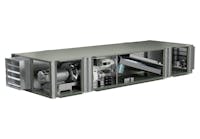Pressure-Independent Valves Simplify Air Base's Transition to Variable Flow
At Eglin Air Force Base in Northwest Florida, a chilled-water plant known as Building 42 was laid out in a primary/secondary configuration, with the intent to utilize variable flow through the secondary loop to save energy. Because of budget constraints, however, variable-speed drives never were installed on the plant's secondary pumps. Rather, the entire system ran at constant speed, regardless of cooling load, generating 2,800 gpm 24/7 and consuming an average of nearly 4.16 million kwh per year.
Aware that this was operationally expensive, the engineering staff at Eglin was eager to upgrade the system. Opportunity came in the form of a utility energy-service contract (UESC) with Gulf Power, the local utility.
Gulf Power enlisted the help of Chevron Energy Solutions to conduct a feasibility study and develop a proposal for $6.8 million in energy-related projects at Eglin, including the optimization of Building 42. The feasibility study indicated that significant energy savings could be realized by converting the chilled-water system to variable-volume flow by installing variable-speed drives on the secondary and tertiary pumps and two-way pressure-independent valves at the cooling coils.
Pressure-independent characterized control valves (PICCVs) from Belimo Aircontrols were chosen for the project.
“You can do (variable flow) with standard two-way valves, but it is tricky,” Spencer O'Quinn, project manager for the Federal Business Unit of Chevron, said. “With Belimo PICCV valves, you just need to maintain a minimum 5-psi drop across the valve, and it automatically maintains proper flow to your circuits. Standard two-way valves, which have many different pressure requirements, will hunt all over the place in a variable-flow system.”
A PICCV provides consistent flow over its entire operating range (5 to 50 psi) by automatically absorbing excess pressure so that its internal control valve always sees a constant pressure drop. Better stability means enhanced fine tuning, so comfort is improved while less energy is consumed.
Matt Woods, sales engineer for Eglin's controls contractor, Systems Specialists Inc., said PICCV actuators' acceptance of multiple inputs makes them easy to apply in retrofits like the one at Eglin, where types of input signals vary from building to building.
30-PERCENT REDUCTION IN KILOWATT-HOURS
Sixty-two PICCVs were installed in the secondary and distribution loops at Eglin. The valves were installed in air-handling units and fan-coil units throughout the six buildings served by Building 42. With the new variable-flow system in operation and the valves distributing flow only when and where needed, Eglin was able to eliminate six building chilled-water booster pumps. Furthermore, the secondary pumps that once ran at 100 percent are getting the job done at 50 to 60 percent of capacity.
Chevron estimated $669,500 in total annual savings and $400,000 in capital-cost avoidance as a result of the overall UESC, which included energy-conservation measures unrelated to the chilled-water system. While the role the reduction in pumping horsepower played in the savings is difficult to quantify, Alan Mardis, electrical engineer and energy manager for the 796 Civil Engineering Squadron, believes it to be significant. Otherwise, the variable-speed drives likely would be running the pumps at approximately 83- to 87-percent capacity at all times.
Based on a comparison with average January usage from years prior to the variable-speed conversion, “I know for a fact we saved over 100,000 kwh in the month of January 2007,” Mardis said.
Overall, Mardis has seen a 30-percent reduction in average kilowatt-hours, which he attributes directly to the chilled-water-optimization project.
“With constant volume, we ran both chillers all the time,” Mardis said. “Now, we can run just one chiller, often at part load. And when there isn't a high load, the building booster pumps don't have to run at all.”
Matt Ossi, Chevron's lead engineer, said: “Variable flow greatly reduces pumping energy over constant flow, especially during the cooler months. During the winter, many of the secondary distribution pumps are offline. What used to be 300 hp of constant-flow pumping can now operate on about one-eighth of that same power and satisfy cooling requirements in the winter. Savings during the summer are significant, but less drastic.”
Chevron and Mardis are looking forward to another UESC project with Gulf Power that will use the same pressure-independent technology to capitalize on savings from variable flow.
“To me, this project shows how significant pressure-independent technology can be in the greater scheme of performance-contracting projects,” Dan Dix, senior sales manager for Belimo, said. “We tend to think of larger equipment like chillers and pumping systems as being central to these projects, but the savings could not occur without accurate, consistent flow control.”
Information courtesy of Belimo Aircontrols.
Circle 148
For Design Solutions author guidelines, call Scott Arnold, executive editor, at 216-931-9980, or write to him at [email protected].








